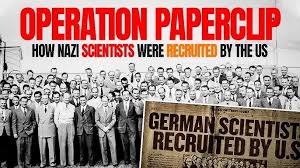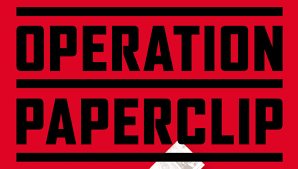
Pics Courtesy Net
Operation Paperclip was a secret program conducted by the U.S. government at the end of World War II. It aimed to recruit German scientists, engineers, and technicians—many of whom had worked for the Nazi regime—to work in the United States. The program was driven by the desire to leverage their expertise in science and technology, particularly in rocketry, aeronautics, and chemical and biological weapons, to gain an advantage over the Soviet Union during the early Cold War.
Origins and Motivation. The Office of Strategic Services (OSS) initiated the program, which later became the CIA and was overseen by the Joint Intelligence Objectives Agency (JIOA). The primary goal was to secure German scientific expertise before it could fall into Soviet hands as part of the larger geopolitical rivalry between the U.S. and the USSR.
Key Figures. Over 1,600 scientists were recruited, including figures such as Wernher von Braun and Kurt Blome. Many of these individuals were members of the Nazi Party or implicated in war crimes, raising ethical concerns.
-
- Wernher von Braun. Director of the V-2 rocket program, which used forced labour from concentration camps like Mittelbau-Dora. Thousands of prisoners died due to harsh conditions and mistreatment. He became a central figure in the U.S. missile and space programs and developed the Redstone rocket, America’s first operational ballistic missile. He also played a pivotal role in NASA, leading the team that developed the Saturn V rocket, which launched Apollo missions to the moon. He is celebrated as a visionary of space exploration, but his involvement with the Nazis and the use of slave labour cast a shadow on his achievements.
-
- Kurt Blome. Deputy Surgeon General of the Third Reich and head of Nazi biological warfare research. He conducted experiments on prisoners, including attempts to weaponise plague and other diseases. Despite being tried at the Nuremberg Doctors’ Trial for war crimes, he was acquitted and recruited to work on U.S. biological warfare programs. His expertise influenced Cold War bioweapons research.
-
- Arthur Rudolph. Production manager of the V-2 rocket program at Mittelwerk, which used concentration camp labour under brutal conditions. He became a key figure in the U.S. missile program, helping to develop the Pershing missile and Saturn I rocket. He was forced to renounce U.S. citizenship in 1984 after his Nazi ties were publicly exposed.
-
- Hubertus Strughold. He conducted human experiments related to aviation medicine, such as exposing prisoners to extreme cold and low oxygen conditions. He is known as the “Father of Space Medicine” in the U.S., contributing to the physiological understanding required for human spaceflight. His name was removed from a NASA award in the 1990s following revelations about his Nazi past.
Contributions to U.S. Programs. Paperclip scientists’ expertise gave the U.S. a significant edge in the arms race and space race against the Soviet Union. These scientists significantly advanced U.S. military and space capabilities, including the development of ballistic missile technology, including the Redstone and Saturn rockets, early contributions to the U.S. space program, culminating in the moon landing, and advancements in aerodynamics, chemical weapons, and medical research.

Moral Paradox. Operation Paperclip remains a moral paradox. On the one hand, it contributed to remarkable achievements such as the moon landing and advancements in military defence. On the other, it allowed individuals complicit in atrocities to escape accountability, reflecting how Cold War exigencies often overrode ethical considerations. The program showcased the tension between moral accountability and pragmatic decision-making during the Cold War. Some of the scientists were accused of direct involvement in atrocities, including forced labour and experiments on concentration camp prisoners. The U.S. government sanitised their records to avoid public backlash and legal challenges, concealing their Nazi affiliations and war crimes. The U.S. government’s willingness to whitewash war crimes for geopolitical advantage remains controversial.
Operation Paperclip was a double-edged sword. While it accelerated U.S. technological progress and Cold War readiness, it also highlighted the moral compromises made to pursue geopolitical advantage. The program remains controversial as an example of prioritising strategic gains over justice and accountability.
Your valuable comments are most welcome.
For regular updates, please register your email here:-
References and credits
To all the online sites and channels.
References:-
- Jacobsen, Annie. “Operation Paperclip: The Secret Intelligence Program That Brought Nazi Scientists to America.” New York: Little, Brown and Company, 2014.
- Lasby, Clarence G. “Project Paperclip: German Scientists and the Cold War.” New York: Atheneum, 1971.
- Neufeld, Michael J. “The Rocket and the Reich: Peenemünde and the Coming of the Ballistic Missile Era.” Cambridge, MA: Harvard University Press, 1995.
- Simpson, Christopher. “Blowback: America’s Recruitment of Nazis and Its Effects on the Cold War.”, New York: Weidenfeld & Nicolson, 1988.
- Broad, William J. “Teller’s War: The Top-Secret Story Behind the Star Wars Deception.” New York: Simon & Schuster, 1992.
- Biddle, Tami Davis. “Technological Knowledge and Ethical Ambiguity: The Legacy of Operation Paperclip.”, Journal of Military History, Vol. 62, no. 4 (1998): 781–810.
- Simpson, Christopher. “The Ethical Quandary of Postwar Science: Operation Paperclip and its Long Shadow.” American Historical Review, Vol. 93, no. 3 (1995): 543–567.
- Neufeld, Michael J. “Wernher von Braun, the SS, and the Concentration Camps.”, Technology and Culture, Vol. 31, no. 3 (1990): 569–599.
- Fox, Robert J. “Nazi Scientists in America: Scientific Advancement or Moral Compromise?”, Ethics & International Affairs, Vol. 8 (2002): 112–129.
Disclaimer:
Information and data included in the blog are for educational & non-commercial purposes only and have been carefully adapted, excerpted, or edited from reliable and accurate sources. All copyrighted material belongs to respective owners and is provided only for wider dissemination.
